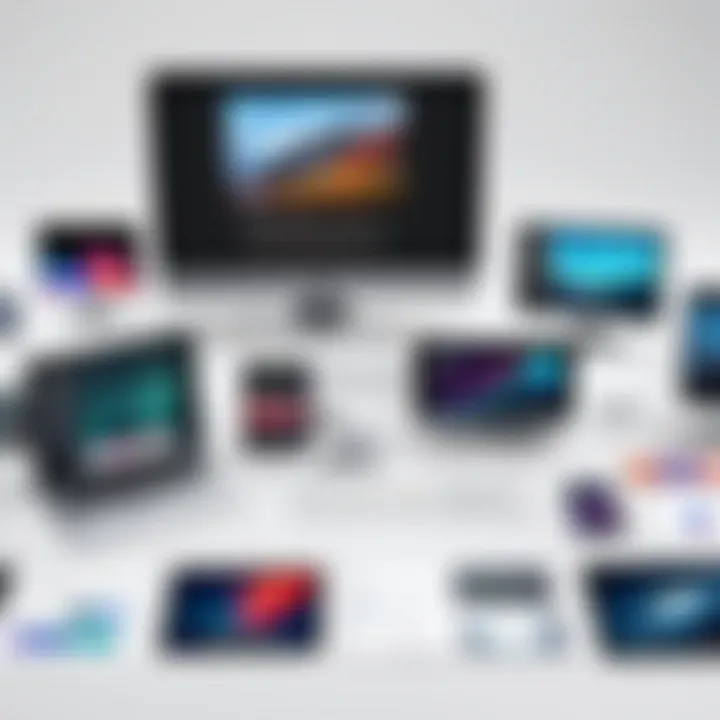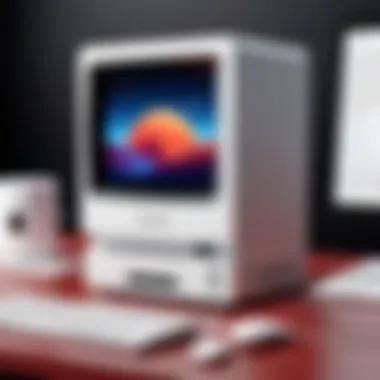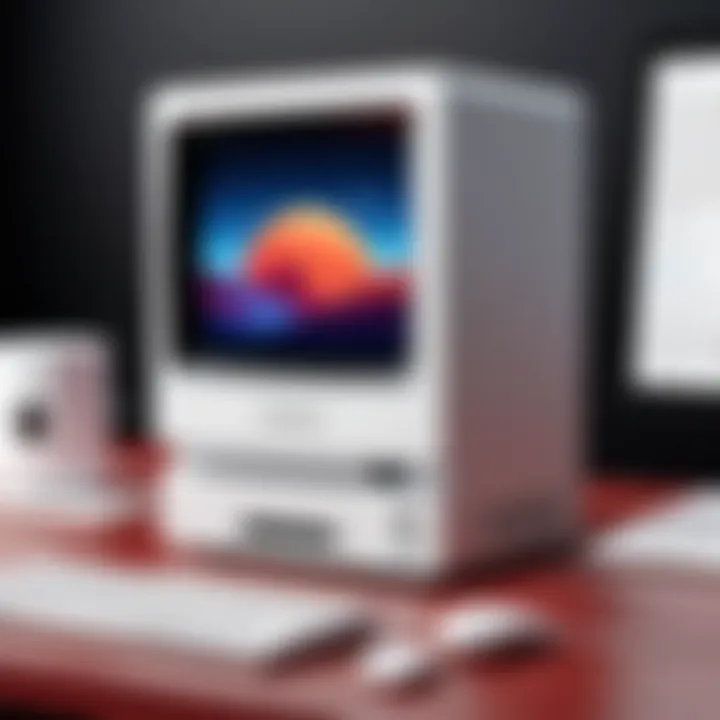The Evolution and Impact of Macintosh in Tech History


Intro
The genesis of the Macintosh computer marks a significant turning point in the world of technology. Launched in the early 1980s by Apple Inc., it was not just another personal computer; it represented a philosophical shift in how humans interact with machines. From the get-go, Macintosh was designed with the user in mind, prioritizing ease of use above all. It introduced a graphical user interface, which was a radical departure from the text-based systems of the time. This article sets the stage to explore the depths of Macintosh’s evolution, spotlighting its historical context, technological milestones, and lasting cultural effects.
In the sections that follow, we will delve into various dimensions of the Macintosh experience—its key features, the technical specifications that set it apart, its performance through rigorous testing, and how it fares in real-world environments. With a focus on technology professionals and enthusiasts, this analysis also aims to unpack the broader implications of Macintosh on the tech landscape as we know it today.
Let’s embark on this journey through time, examining not just a product, but an enduring legacy that continues to shape technological discourse and user expectations.
Historical Context of Macintosh
The historical context of Macintosh is vital in understanding how this computing system has shaped and influenced the broader landscape of technology. When examining the origins of Macintosh and its evolution, one recognizes the pivotal shifts in user expectations and the technological advancements that transformed personal computing. The Macintosh, often heralded for its innovative design philosophy, not only addressed the needs of users but also inspired a shift in industry standards. This section encapsulates the essence of how the Macintosh journey began and the remarkable milestones that punctuated its development.
Origins of the Macintosh
The origins of the Macintosh can be traced back to the late 1970s, a period teeming with innovation and burgeoning interest in personal computing. Apple's co-founder Steve Jobs envisioned a computer that would be more accessible to the general public. The idea was not merely to create another piece of hardware but to develop a seamless user experience that could captivate non-technical users.
In 1984, Apple launched the original Macintosh, marketing it as the first mass-market personal computer to feature a graphical user interface (GUI). This was a game-changing moment. Unlike the text-based interfaces that dominated computing at the time, the Macintosh allowed users to interact with their computer using visual icons and a mouse.
The original Macintosh was not just a product; it was a reflection of an era where technology began to merge with creativity and user-centric design.
The release of the Macintosh was paired with a memorable advertisement during the Super Bowl that year, showcasing its revolutionary potential. This marketing campaign became legendary, capturing the attention of tech enthusiasts and the general populace, heralding a new dawn in computing.
Key Milestones in Development
Throughout its history, the Macintosh has undergone numerous milestones that mark its evolution and development. Here are some significant moments:
- 1984: Original Macintosh Launch
Marked the entry of GUI-driven personal computing, changing how users interacted with technology. - 1987: Macintosh II
This model introduced color graphics, a major leap forward, positioning the Macintosh as a tool not just for business but for creative professionals as well. - 1998: iMac G3
The iMac G3 fused style with functionality, featuring a unique, colorful design that became a cultural icon and attracted a new wave of users. - 2001: OS X
A complete overhaul in the operating system, bringing advanced features such as Unix-based architecture and a more stable operating environment. - 2010: MacBook Air
With its sleek design and portability, the MacBook Air set new trends in laptop design, influencing competitors across the industry.
These milestones not only reflect the technological advancements in the Macintosh product line but also underscore the shifts in user demands and preferences over time. The resilience and adaptability of Macintosh's development story have greatly contributed to its lasting legacy in the technology landscape.
Technological Innovations
The realm of Macintosh is laced with groundbreaking technological innovations that have reshaped personal computing and influenced the very fabric of modern technology. These innovations are not merely footnotes in history; they are the bedrock upon which the present-day user experience is built. Recognizing the pivotal role of these innovations helps us understand why Macintosh remains a darling of creative professionals, tech enthusiasts, and everyday users alike.
User Interface Evolution
The evolution of the user interface in Macintosh systems represents a journey from command-line interactions to graphical user interfaces (GUIs) that revolutionized user experience. Early Mac systems were among the first to shift from typed commands to visually-driven interactions, making technology more accessible. Particularly noteworthy is the introduction of the desktop metaphor, where folders and files appeared visually as real-world objects. This concept was not just a neat gimmick; it fundamentally changed how users interacted with their computers, lowering the barrier for adoption among non-technical individuals.
Users no longer needed to memorize complex codes or navigate arcane command structures. Instead, they could click and drag, making day-to-day tasks feel intuitive. The impact of this evolution is seen in numerous modern operating systems, which have borrowed aspects of the Macintosh's interface. Features like multi-touch gestures and cohesive design language can trace their lineage back to these early innovations.
"The Macintosh taught users that computing could be simple and beautiful, not just functional."
This shift in design philosophy not only improved usability but also created a new standard of aesthetics in computing. Light colors and smooth lines became synonymous with Macintosh, showcasing how design could indeed enhance function.
Hardware Advancements
Macintosh systems have been at the forefront of hardware advancements, offering capabilities and performance metrics that often set the tone for the industry. With its introduction of the all-in-one design, the original Macintosh laid groundwork for compact computing systems. Unlike its contemporaries, which often required bulky monitors and separate cases, the Macintosh combined everything into a sleek package that appealed to both aesthetics and space efficiency.
Over the years, Apple continued to push technological boundaries. Each iteration saw improvements in processing power, graphic capabilities, and storage solutions. The transition from the PowerPC architecture to Intel chips exemplified Apple's determination to keep pace with the changing landscape of technology. The result was not only a significant increase in performance but also an expansive array of software options that previously weren't feasible.
Moreover, the introduction of Retina displays transformed visual experience on the computer. It elevated graphics and text clarity, catering especially to professionals in design and photography, who demand high fidelity and detail in their work. Hardware advancements in Macintosh also extend to peripherals, with products like the Magic Mouse and the MacBook’s trackpads becoming benchmarks in user interaction.
Software Ecosystem Overview
The software ecosystem that has developed around Macintosh has been equally as influential as its hardware advancements. From the very beginning, Macintosh was designed with a focus on ease of use and a seamless user experience. macOS integrates a host of applications that facilitate productivity across a wide range of professional fields.
Software like Final Cut Pro for video editing and Logic Pro for music production showcases Macintosh's commitment to creative professionals. These applications are not just bolted-on features; they are deeply integrated into the Macintosh experience, allowing users to harness the full potential of the system's capabilities.
Furthermore, the App Store revolutionized the way users access software. It offered a centralized marketplace where both consumers and developers could benefit from innovative solutions, yet still adhering to robust safety and quality standards. This ecosystem has nurtured a vibrant community of independent developers, ensuring that users have access to cutting-edge applications that can maximize their productivity.
In summary, the technological innovations stemming from Macintosh have set benchmarks across the computing landscape. From user interface design to hardware evolution and software development, the legacy of Macintosh continues to resonate, shaping user experiences while pushing the upcoming standards for technology. This rich tapestry of innovations not only outlines the history of Macintosh but illuminates its ongoing influence in the tech ecosystem.


Cultural Impact
The cultural impact of Macintosh extends far beyond its hardware and software innovations. It has carved a niche in society, influencing how we communicate, create, and perceive technology. Understanding this cultural significance enriches our view of Macintosh and reveals its role as a symbol of creative expression and innovation. This section examines two key facets: its representations in popular culture and its profound effect on design philosophy.
Macintosh in Popular Culture
From the outset, Macintosh wasn’t just a computing hardware; it became a cultural icon. It revolutionized not only how people interacted with computers but also how these devices integrated into everyday life. The early ads, particularly the memorable 1984 Super Bowl commercial directed by Ridley Scott, presented Macintosh as a liberating force against the conformity of traditional computing, representing a break from the norm. This powerful imagery set the stage for the Macintosh's enduring legacy in pop culture.
People often associate Macintosh with creativity and innovation. Musicians like The Beatles, and contemporary artists like Katy Perry, have openly embraced Macs in their creative processes. Equally, in films, you often see characters using Macintosh computers, signaling a status of creativity and forward-thinking. Movies like "The Social Network" showcase developers coding on Macs, emphasizing their role in shaping the tech revolution. Mac’s presence in media isn’t just accidental; it’s a testament to how intertwined this brand has become with the narrative of technology and creativity.
The cultural reach of Macintosh is further illustrated through various art movements that adopted its aesthetic. The sleek and simplistic design of Apple's machines resonates deeply with minimalist design ideals, leading many contemporary designers to look towards them as a source of inspiration. This crossroad of technology and art has sparked endless conversations about the fusion of functionality and beauty in digital design.
Influence on Design Philosophy
Macintosh has had a significant impact on design philosophy, showcasing how a product can embody deeper values. The emphasis that Apple has placed on user experience is not just about comfort, but also about making technology accessible to everyone. The user interface revolutionized with the Macintosh has influenced countless applications and devices, creating a ripple effect throughout the tech world.
In the early years, the Macintosh introduced the icons and graphical interfaces that many still associate with modern computing. This marked a significant shift from text-based commands to more intuitive controls, effectively lowering the barriers to entry for many new users. Designers focusing on user-centered design have drawn inspiration from Macintosh principles, championing simplicity and elegance over complexity.
This commitment to aesthetic unity is evident in today’s product designs, reinforcing the idea that functionality does not have to sacrifice beauty. The phrase “form follows function” resonates with Macintosh’s philosophy, establishing an industry standard that values a seamless blend of usability and design.
Furthermore, Macintosh’s influence can be seen in current discussions around ethical design. The responsibility of tech companies to create inclusive, accessible products is increasingly vital, and Macintosh set the tone early on. Apple’s focus on accessibility features continues to guide designers in creating tools that cater to users of all abilities, showing that design has the power to enhance lives, not just serve needs.
"Technology is best when it brings people together."
— Matt Mullenweg
In summary, the cultural impact of Macintosh extends from its initial forays into personal computing to its current status in the media and design worlds. It fosters creativity, champions design ethics, and inspires a generation of creators and thinkers to embrace technology's potential in enriching lives.
Competitive Landscape
The competitive landscape surrounding Macintosh has shaped its development and market presence significantly. This section looks into the interplay between Macintosh and its competitors, highlighting the strategies, advantages, and challenges that have emerged over the years. Understanding this dynamic is crucial, as it provides insights into Macintosh's enduring appeal and resilience in a fast-paced tech industry.
Macintosh vs. Windows
The rivalry between Macintosh and Windows is perhaps one of the most famous in tech history. Microsoft Windows, being more widely adopted, offers a larger share of the market. Yet, Macintosh, with its unique user experience and ecosystem, has cultivated a loyal customer base. The key difference lies in their approach to user interface and experience.
- User Interface: Macintosh emphasizes a clean, intuitive user interface that appeals to creatives and professionals alike. In contrast, Windows provides broader customization options but can sometimes feel overwhelming.
- System Stability: Many users point to the stability of macOS as a deciding factor when comparing it to Windows, particularly in creative and professional environments.
- Software Compatibility: While Windows boasts a massive library of applications, especially in gaming, Macintosh is favored for creative software like Final Cut Pro and Logic Pro. This has led to a clear dividing line in target demographics: creatives lean towards Macintosh, while gamers often stick with Windows platforms.
As the technologies evolve, both operating systems continue to adapt. Microsoft has undertaken extensive renovations to Windows, enhancing its user interface significantly. Meanwhile, Apple keeps tightening the integration of hardware and software on Macintosh, making the experience seamless and attractive.
"While numbers show Windows as the giant, real innovation often sprouts from the smallest pots."
Emerging Competitors in the Market
Over the years, the tech landscape has been flooded with new competitors challenging both Macintosh and Windows. Companies like Google, with its Chrome OS, and newer brands like Microsoft Surface, have begun carving out segments of the market, particularly in education and hybrid work environments.
- Chrome OS: Simplicity and affordability have made Chrome OS attractive, especially in schools and among budget-conscious consumers. Users appreciate the straightforward interface and integration with Google services.
- Linux Distributions: Linux, although niche, has garnered a following among developers and tech enthusiasts who prefer open-source solutions that offer flexibility and customization without the hefty price tag. This growing user base has prompted a small, yet significant shift towards alternatives outside of Macintosh and Windows.
- Tablets and Hybrid Devices: Devices that bridge the gap between traditional computing and tablets, like the iPad and Microsoft Surface, are increasingly popular. These devices often blur the line, providing users with touch functionality alongside traditional PC capabilities.
As the market continues to evolve, Macintosh might face increasing pressure to redefine its value proposition. Conducting continuous market research and responding to user feedback will be key to maintaining relevance and competitive advantage.
The comparisons drawn within competitors serve not only to highlight Macintosh’s attributes but also reflect the constant evolution of technology in meeting consumer demands.
User Demographics
Understanding user demographics is crucial when analyzing the Macintosh's impact. These demographics, which encompass age, profession, educational background, and even geography, help paint a clearer picture of who is using Macintosh products, why they favor these systems, and how their preferences have evolved over time.
Target Audience for Macintosh Products
Macintosh products appeal to a diverse audience, but several distinct groups stand out. Apple's marketing often targets creative professionals, including graphic designers, filmmakers, and musicians. This is largely because of its robust software like Final Cut Pro and Logic Pro, which are directly aligned with the needs and preferences of these users. Moreover, educational institutions tend to favor Mac for their ease of use and reliability, making them a popular choice in classrooms and universities.
Another group consists of tech-savvy individuals who appreciate the seamless integration of hardware and software that Apple provides. These users often value the aesthetics of the design alongside functionality, creating a unique loyalty to the brand. Tech enthusiasts who look for innovation and cutting-edge technology find Macintosh products very appealing as well.
However, the landscape isn't static. Trends have shown a slight influx of users from backgrounds like business and engineering as they discover the expansive capabilities of macOS and its software ecosystem.


User Preferences and Trends
The preferences of Macintosh users have evolved significantly over time, influenced by changes in technology and society. In the early days, many buyers favored Macintosh for its distinct graphical interface, which was a revolutionary leap compared to the text-based systems of the time. Today, however, users are highly concerned about security features, user privacy, and overall system performance.
Recent studies indicate that users prioritize the following features in their Macintosh experience:
- Security: With rising cyber threats, many users prefer Macintosh for its perceived security robustness compared to competitors.
- User Experience: The intuitive interface continues to be a significant draw. Users appreciate the minimal learning curve and the sleek design of both hardware and software.
- Compatibility: Creative professionals tend to seek software compatibility with industry standards, which Apple caters to effectively.
As we observe shifts in usage patterns, we can see that the target audience is growing, moving beyond creatives to encompass more professional sectors.
The growing interest in remote work has also shifted preferences. More users are seeking machines suitable for multitasking and collaboration tools. Apple's recent focus on enhancing their hardware to support high-performance tasks is a direct response to these changing preferences.
Future Prospects
The discussion surrounding the future prospects of Macintosh isn't just about where the technology stands today; it’s about anticipating how it will evolve and continue to influence both personal and professional domains. As we venture into an era where digital integration becomes increasingly nuanced, understanding these prospects becomes crucial for stakeholders across various sectors, including IT professionals, developers, and end-users.
Several key elements will shape the future of Macintosh, particularly in the realms of product development, market strategies, and user experience. Embracing trends such as cloud computing, artificial intelligence, and enhanced security measures, the Macintosh platform is not just responding to the current needs but also preparing for the unforeseen challenges alongside technological advancement.
Trends and Predictions
Looking ahead, several trends are likely to define the Macintosh ecosystem. Firstly, integration of artificial intelligence can revolutionize the way users interact with their devices. From smart assistants to predictive algorithms that adapt to user behavior, AI is set to elevate user experience. As developers integrate AI into software, the seamless automation of tasks could become the norm.
- Wider adoption of AR and VR technologies will further embed Macintosh in educational and creative industries alongside sophisticated multimedia applications.
- Sustainability will likely be at the forefront, with Apple and Macintosh contributing to eco-friendly measures in product design and electronic waste management.
- Additionally, remote working tools are expected to evolve significantly, reinforcing Macintosh's position as a go-to option for professional environments.
While the landscape certainly appears promising, it’s essential to acknowledge potential challenges that lie ahead.
Potential Challenges Ahead
The road ahead for Macintosh isn’t devoid of obstacles that could impede its progress. First and foremost, the competitive landscape has grown fiercer. With companies like Microsoft continuously enhancing their offerings, Macintosh must innovate rapidly to maintain its market share. Users often weigh choices based on features and cost, and any slip-up could lead to a shift in loyalty.
Furthermore, as dependence on cloud services increases, concerns about data privacy and security will remain paramount. Although Macintosh has a strong reputation for security, any breaches or vulnerabilities could erode user trust.
- The emergence of subscription models for software rather than traditional purchasing needs to resonate well with users who may seek more flexible, cost-effective solutions.
- Moreover, keeping development teams motivated and aligned with user needs while also ensuring they are equipped with the required resources can be challenging, especially in rapid growth phases.
"Without continuous adaptation and foresight, even the mightiest technology could falter in the waves of change."
Comparative Analysis
The comparative analysis of Macintosh against various benchmarks is critical to understanding its standing in the tech industry. This section, in particular, dives into two fundamental dimensions: performance benchmarking and the interplay between cost and performance. By comparing Macintosh systems to alternative operating systems and hardware, IT professionals and tech enthusiasts can glean insights into what makes Macintosh unique—and where it may lag behind the competition.
Performance Benchmarking
When we talk about performance benchmarking, we put different systems through their paces to see how they hold up under real-world conditions. This involves using specific metrics to gauge processing speeds, graphical capabilities, and responsiveness to user commands. For Macintosh systems, there are notable performance attributes worth considering:
- Processing Power: Regardless of whether it's an M1 chip or the latest M2 processor, these innovations bring impressive multi-core performance. This is particularly noticeable in tasks requiring heavy lifting, such as video editing or software development.
- Graphics Performance: For creative professionals, graphics performance can be the bread and butter of their work. Benchmark tests often highlight how Macs face off against Nvidia and AMD graphics in terms of rendering speeds and efficiency.
- User Experience: The overall snappiness of the user interface is also essential. Benchmarking isn't just about raw horsepower; it's about how seamlessly the hardware and software interact under various loads.
While some may argue that just looking at the specs gives a narrow view, even a cursory glance at these figures reveals how Macintosh holds its own or needs improvement when lined up against competitors like Dell or HP.
"Performance is not just about the numbers; it’s how those numbers translate into the user experience."
Cost vs. Performance
The cost of Macintosh products often garners mixed reactions. It's not uncommon to hear tech enthusiasts waxing poetic about the capabilities of a Mac while simultaneously hearing criticisms about its price tags. Here, we can break down the conversation further:
- Initial Investment: Yes, Macs tend to demand a premium upfront cost. However, their longevity and resale value often balance that equation.
- Total Cost of Ownership: Beyond the initial sticker price, it’s crucial to consider the total cost over time. This includes software updates, customer service experiences, and longevity.
- Value in Creative Economies: For fields such as graphic design and music production, Macs often represent a worthwhile investment due to specialized software, like Final Cut Pro and Logic Pro, which might not perform as robustly on other systems.
Educational Use Cases
The influence of Macintosh in educational settings extends beyond mere hardware and software. It represents a paradigm shift in how learning environments are constructed, making technology an essential partner in education. Looking at how educational use cases have evolved, we can appreciate the myriad benefits that emerge from integrating Macintosh systems into the classroom, training facilities, and workshops.
Macintosh in Academic Settings


The introduction of Macintosh computers into academic settings has been both revolutionary and transformative. For many institutions, adopting Macintosh was more than a choice of brand; it was a commitment to a user-friendly interface and powerful multimedia capabilities. Macintosh has often been the go-to choice for creative courses, including graphic design, film studies, and music production. With powerful tools like Final Cut Pro and Logic Pro, students can engage in hands-on learning experiences that are both practical and relevant.
Moreover, as educators embrace project-based learning, Macintosh computers provide the necessary resources to support these endeavors. Tools like iMovie and GarageBand allow students to create presentations, documentaries, and podcasts easily. Using these platforms nurtures creativity while honing technical skills, which are increasingly vital in today’s job market.
"In a digital age, using the right tools can make all the difference in educational outcomes."
Training and Workshops
Training and workshops that leverage Macintosh technologies allow participants to dive deep into software ecosystems relevant to today's demands. Whether it’s Apple’s coding language Swift or hands-on training with design tools like Adobe Creative Suite, Macintosh provides a solid foundation for both instructors and learners.
The benefits of training on Macintosh systems can be listed as follows:
- User-Friendly Interface: The intuitive design gets learners started without a steep learning curve and enables them to focus on content over navigation.
- Strong Focus on Collaboration: Many applications support real-time collaboration. For example, Apple’s iWork suite allows users to share and work on documents simultaneously, fostering teamwork.
- Comprehensive Learning Tools: There are countless educational applications available on the Mac App Store, catering to diverse subjects from programming to art, ensuring encompassing development opportunities.
With the increase in remote learning environments, the adaptability of Macintosh technology offers educators unique opportunities to hold online workshops. Tools like Zoom, combined with Mac’s compatibility with various platforms, make it feasible for both instructors and students to navigate learning without being physically together. As technology continues to change, the importance of engaging with engaging educational tools remains a constant.
In sum, the integration of Macintosh in educational settings underscores its longstanding impact, shaping not just individual learners but entire educational paradigms.
Macintosh in Creative Industries
When we think about the role of Macintosh in the creative sectors, it’s hard not to feel that old familiar itch of nostalgia. Macintosh computers have woven themselves into the fabric of design and multimedia work because of their unique ability to perform under pressure while delivering stunning visuals. This section shines a light on how Macintosh not just nudged but sometimes practically shoved creative professionals into new horizons.
One of the strongest defining features of Macintosh in creative industries is its focus on design and ease of use. Unlike many PCs which often come with a tangle of software and configurations that can confuse even the savviest techie, Macintosh keeps things user-friendly. This has rendered it a favorite among graphic designers, artists, and musicians alike. The allure lies in seamless workflow, where creativity can take center stage without being bogged down by technological fuss.
Design and Multimedia Applications
Diving deeper into the applications, we find that Adobe Creative Suite, Final Cut Pro, and Logic Pro are at the top of the list when it comes to design and multimedia capabilities on Macintosh systems. Each software package not only runs with remarkable efficiency on Mac but also offers unique features that cater to the creative mind.
- Adobe Photoshop and Illustrator: Renowned among graphic designers, these tools are optimized for Macintosh, allowing for high-quality image editing and vector graphic design. The smooth rendering and the ability to manage high-resolution files without lag are just a couple of reasons these programs remain staples on Macintosh.
- Final Cut Pro: This video editing software is a darling for filmmakers and content creators. It offers powerful effects and an intuitive interface, making it the go-to choice for professionals in the film industry. Furthermore, it allows for effortless integration with other Apple products, contributing to an efficient post-production process.
- Logic Pro: For audio professionals, this digital audio workstation doesn’t just provide a platform for music creation but transforms the entire studio experience. It comes packed with features that take music production to a whole new level, supporting everything from simple recordings to intricate orchestral arrangements.
Embracing these tools allows creative individuals to push boundaries and explore new methods of expression. The emphasis on high-resolution graphics and high fidelity audio becomes essential, particularly when producing work that exists to captivate and inspire.
Software Development Environments
On the flip side, Macintosh also stands tall in the world of software development. The preference among developers for building applications tailored for creative industries can be traced back to the robust environments provided by tools such as Xcode and Terminal. Working in these environments is often favored due to the UNIX-based architecture of macOS, which allows developers to dive deep into systems without getting their feet stuck in mud.
Here, code isn’t just lines; it becomes art. Some advantages include:
- Swift Development: The introduction of the Swift programming language made waves. It allows developers to write safer and more efficient code, becoming a hit for those looking to create robust applications that cater to the creative market.
- Simplicity of Setup: Getting started with software development on Mac is often seen as smoother compared to other platforms. The ability to run various operating systems using tools like Parallels or Docker adds to versatility, allowing developers to test applications in diverse environments without jumping through hoops.
- Community Support: The vibrant community surrounding Macintosh contributes immensely. Forums and resources on platforms like Reddit offer a treasure trove of knowledge. Many users share their experiences, tips, and hacks, fostering a spirit of collaboration and support that's invaluable.
To recap, it's not just about the end product; it’s about what the Macintosh toolset offers to those creating it. The integration of design and functionality makes it a cornerstone for professionals who think outside the box and aren’t afraid to challenge the status quo.
"The Macintosh fosters creativity not merely through its hardware but through a culture of innovation that inspires users to redefine the boundaries of possibility."
As we navigate the interplay between Macintosh systems and creative industries, one can’t help but appreciate the ongoing symbiotic relationship, a narrative still being written as technologies evolve. It's clear Macintosh isn’t just participating in the creative game; it’s writing some of the rules.
Macintosh and Security
As the digital age has unfurled its complex tapestry, personal and corporate security has become increasingly critical. Macintosh systems, often perceived as a beacon of stability and user-friendliness, have also made significant strides in the realm of security. Understanding these features is crucial not only for regular users but also for IT professionals and tech enthusiasts who wish to harness the power and security of these systems effectively. Security in Macintosh is not just about defending against threats; it is about fostering a culture of privacy and trust within the tech community.
Security Features and Protocols
Apple has built a robust fortress of security protocols around its Macintosh systems. Some of the standout features include:
- System Integrity Protection (SIP): This feature acts like a vigilant guardian, preventing malware from modifying protected files and folders. It restricts the actions scripts and processes can take to safeguard the core of the operating system.
- Gatekeeper: Serving as the sentry at the gates, Gatekeeper ensures that only software from identified developers can be run, adding an additional layer of defense against malicious applications.
- FileVault: This encryption tool provides users with the ability to encrypt their entire disk. Data becomes virtually inaccessible without the correct passphrase, ensuring confidentiality even if the device falls into the wrong hands.
- XProtect: Apple's built-in malware detection system actively scans for known threats, blocking potentially harmful software before it can do any damage.
"Security is not a product, but a process." - Bruce Schneier
These features collectively create an ecosystem where users can perform their daily tasks with a sense of security. With constant software updates, Apple remains vigilant against emerging threats, adapting and refining its protocols to meet new challenges in cybersecurity.
User Privacy on Macintosh Systems
Privacy is another paramount concern that intertwines with security in Macintosh environments. Apple has carved out a distinct position in the tech landscape by making privacy a baseline expectation for its users. Some notable aspects include:
- Privacy by Design: From the outset, Macintosh systems are built with user privacy in mind. Settings are easily accessible, allowing users to manage their data protection preferences with minimal fuss.
- Transparency Reports: Apple regularly publishes privacy reports, detailing government data requests and information about its commitment to user privacy.
- Location Services Control: Users have granular control over what apps can access their location, a feature not always afforded by other systems.
- App Tracking Transparency: Users can opt to restrict apps from tracking their behavior across platforms, drastically limiting data collection from third parties.
With these advances, users of Macintosh systems can feel a sense of empowerment and control over their personal information. Implementing best practices around software updates and security settings fosters a safer computing environment. In a world where personal data is akin to currency, understanding and leveraging these security features is essential for anyone using or working with Macintosh devices.
Ultimately, Macintosh security is not merely a technical subject; it speaks to a broader narrative about user trust, privacy, and the evolving landscape of technology. Professionals and enthusiasts alike benefit from remaining informed about these developments, ensuring they engage with their tools and systems in a secure, informed manner.



